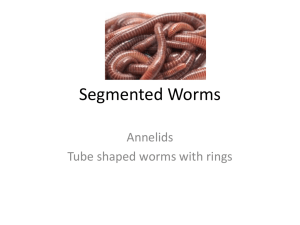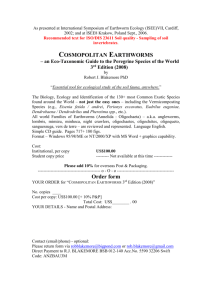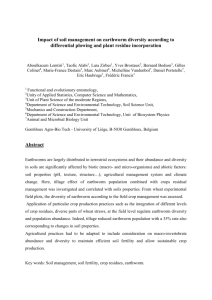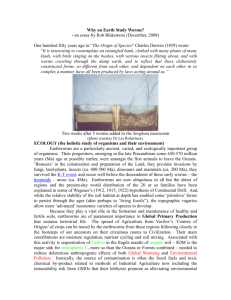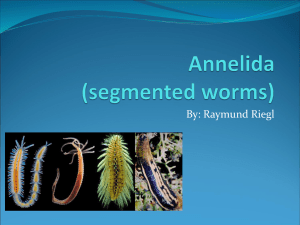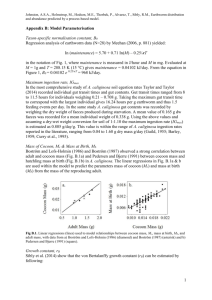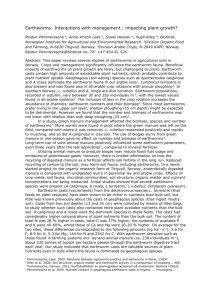Patterns of aestivation in tropical earthworms - digital
advertisement
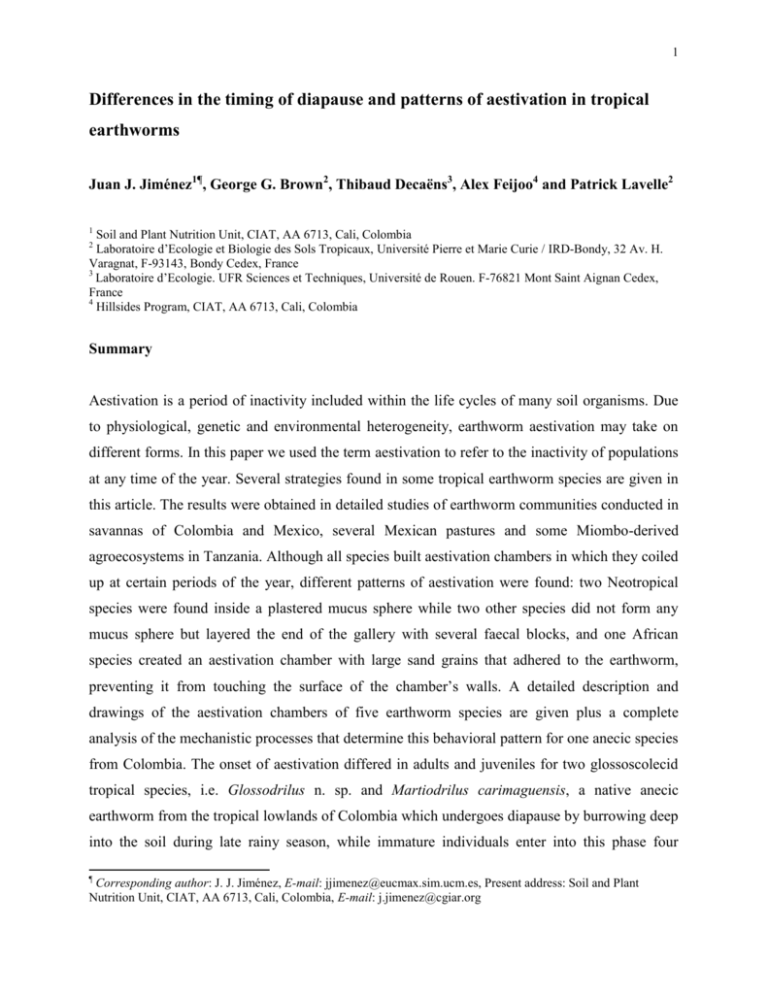
1 Differences in the timing of diapause and patterns of aestivation in tropical earthworms Juan J. Jiménez1¶, George G. Brown2, Thibaud Decaëns3, Alex Feijoo4 and Patrick Lavelle2 1 Soil and Plant Nutrition Unit, CIAT, AA 6713, Cali, Colombia Laboratoire d’Ecologie et Biologie des Sols Tropicaux, Université Pierre et Marie Curie / IRD-Bondy, 32 Av. H. Varagnat, F-93143, Bondy Cedex, France 3 Laboratoire d’Ecologie. UFR Sciences et Techniques, Université de Rouen. F-76821 Mont Saint Aignan Cedex, France 4 Hillsides Program, CIAT, AA 6713, Cali, Colombia 2 Summary Aestivation is a period of inactivity included within the life cycles of many soil organisms. Due to physiological, genetic and environmental heterogeneity, earthworm aestivation may take on different forms. In this paper we used the term aestivation to refer to the inactivity of populations at any time of the year. Several strategies found in some tropical earthworm species are given in this article. The results were obtained in detailed studies of earthworm communities conducted in savannas of Colombia and Mexico, several Mexican pastures and some Miombo-derived agroecosystems in Tanzania. Although all species built aestivation chambers in which they coiled up at certain periods of the year, different patterns of aestivation were found: two Neotropical species were found inside a plastered mucus sphere while two other species did not form any mucus sphere but layered the end of the gallery with several faecal blocks, and one African species created an aestivation chamber with large sand grains that adhered to the earthworm, preventing it from touching the surface of the chamber’s walls. A detailed description and drawings of the aestivation chambers of five earthworm species are given plus a complete analysis of the mechanistic processes that determine this behavioral pattern for one anecic species from Colombia. The onset of aestivation differed in adults and juveniles for two glossoscolecid tropical species, i.e. Glossodrilus n. sp. and Martiodrilus carimaguensis, a native anecic earthworm from the tropical lowlands of Colombia which undergoes diapause by burrowing deep into the soil during late rainy season, while immature individuals enter into this phase four ¶ Corresponding author: J. J. Jiménez, E-mail: jjimenez@eucmax.sim.ucm.es, Present address: Soil and Plant Nutrition Unit, CIAT, AA 6713, Cali, Colombia, E-mail: j.jimenez@cgiar.org 2 months earlier. Relationships between the aestivation period and the addition of new segments in earthworms have been established by several authors. In this study there was no relationship for the only species studied in more detail. Key words: Earthworms, Aestivation, Diapause, Adaptive strategies, Savannas Introduction Some living organisms have the ability to enter either a phase of inactivity or a type of dormancy when environmental conditions are unsuitable. Aestivation1 is a period included within the life cycle of many soil organisms. It may be defined as the ability of an organism to cease activity during time periods of variable length. Almost all earthworm species display this mechanism as a response to seasonal changes of both soil moisture and temperature. During this phase of inactivity individuals remain at deeper soil layers, fasting and immobile, and may even regress their primary and secondary sexual characters. According to Bouché (1972; 1984) and Olive & Clark (1978, op. cit. Lee 1985) three types of inactivity may be distinguished, although the limits are not clearly defined and, depending on environmental stress, several intermediate stages may exist (Lee 1985): 1. Quiescence. This process occurs when environmental conditions change. Individuals regain activity when the conditions that initiated the process become suitable once more. They do not build an aestivation chamber neither remain rolled up, but instead remain extended, so that dehydration is severe. They may empty their guts, but sexual characters are not reabsorbed. 2. Paradiapause (= Facultative diapause, Saussey 1966, op. cit. Lee 1985). This type of lethargy is induced by desiccation of the soil environment. Suppression of the inductive factors results in resumption of activity. Each individual builds an aestivation chamber and rolls itself up 1 We refer here to the inactivity of populations at any time of the year 3 after emptying its gut contents. There is a regression of sexual characters and dehydration is much reduced. 3. Diapause. The obligatory diapause is physiologically induced by adverse conditions. It is produced by an environmental factor but the end (resumption of activity) is determined at the physiological level. Unlike paradiapause, there is no response when, artificially, individuals are returned to suitable conditions, i.e., when earthworms are introduced into moistened soil at field capacity (pF 2.8). Individuals also construct an aestivation chamber and lose weight as a consequence of emptying their gut, but without dehydration. Sexual character reabsorption occurs and sometimes tissue regeneration takes place during this phase. Many authors have described the types of strategies earthworms display in entering inactivity, quiescence or diapause (Abeloos & Avel 1928; Evans & Guild 1948; Lee 1951; Saussey 1966; Satchell 1967; Bouché 1972, 1984; Morgan & Winters 1991). However, few studies have illustrated the patterns of aestivation chamber formation. The purpose of the present work was to graphically illustrate a variety of observed aestivation chambers in several tropical earthworm species from different families and continents, and to establish the details of aestivation mechanisms (induction), both physiological and edaphic for one anecic species from the savannas (“Llanos”) of Colombia. Materials and Methods Earthworm aestivation was assessed from detailed studies of earthworm communities undertaken over 18 months at Carimagua (Colombia) and La Víbora (Mexico), and from field observations in agroecosystems around Gairo (Tanzania), Isla, Tuxpan and Carranza (Mexico) as part of three international projects (funded by the EU, IFS and AECI). Aestivating earthworms and diapause chambers were observed during hand-sorting of earthworms collected at different depths within soil monoliths of different sizes (Lavelle 1978; Anderson & Ingram 1993). Colombian site 4 The main field work was undertaken within the Carimagua Research Station (CIATCORPOICA) in the Eastern Plains of Colombia (4 37’ N and 71 19’ W, 175 m altitude). Mean annual rainfall is 2200 mm and the average temperature is 26ºC (1973-1995 period). A strong seasonality of the rainfall results in a 4-month long dry season. Soils are infertile oxisols and ultisols (USDA 1975) supporting herbaceous vegetation and scattered tree savannas and gallery forests, mainly including Mauritia spp. palm trees, associated with water channels. Two sites were selected, a natural savanna and a 17-yr old grazed grass-legume pasture (introduced). Detailed sampling of the earthworm communities was performed during eighteen months, from March 1994 to September 1995 (except June 1994), comprising a combination of handsorting of 1m2 x 0.5 m depth monoliths and washing-sieving of 20 x 20 cm cores. Although 0.5 m was the depth normally sampled, this varied seasonally to account for the vertical migration of some species (Jiménez et al. 1998a). Soils blocks were split into 10 cm layers and all earthworms extracted were fixed in 4% formalin (after Lavelle 1978). Sampling ended when, in a certain layer (never <50 cm), no earthworms were found. In some cases, especially in the dry season, monoliths were dug down to 80 cm. Five 1m2 and 10 washing-sieving cores were taken monthly in a completely random stratified block design at both sites. The earthworm community of the native savannas and man-made pastures comprised 8 species, all native (Table 1). In both systems species richness was similar, only one species from the savanna being absent from the pasture. Average annual density and biomass of the earthworm community in the savanna however, were 49.8 ind m-2 and 3.26 g f. w. m-2, much lower than in the pasture (80.1 ind. m-2, 57.1 g f. w. m-2, respectively) due to the larger populations of Martiodrilus carimaguensis Jiménez and Moreno (in press) in the latter system. This species accounts for 88% of the total earthworm biomass (Jiménez et al. 1998b). Mexican sites These sites, located in the Eastern Mexican state of Veracruz, are along the coastal plain (35-80m altitude), presenting a humid and hot seasonal climate with >1200mm rainfall, but a long dry season of 4-6 months, intermittently interrupted by strong N winds and some light rains called “Nortes.” At Isla and La Víbora, soils (ultisol and alfisol, respectively) were of a sandy or loamy sand texture, poor in organic matter (<1.5%C), and the original vegetation was probably shrub 5 and grass savanna. Present vegetation at both sites was native grass pasture. At La Víbora, sampling was performed approximately monthly from June 1996 to September 1997 by manually sorting through soil blocks 25 x 25 cm square, to a depth of about 20 cm (Brown et al. 2000). All earthworms collected were placed in 4% formalin and taken to the laboratory for determination of species and preserved weights. Seven species were collected, one exotic and six native, three of them new to science. In this paper, we refer only to specimens of the new Glossoscolecidae genera, gen. nov.1. The site at Isla was sampled only in the wet (September-October) and dry (May) seasons of 1998 and 1999, using a 50 x 25 cm rectangular pit, to a 40-60 cm depth. At Carranza and Tuxpan, soils were Vertisols, with high clay content (>40%), and richer in C (>2.5%). Original vegetation was tropical lowland semi-deciduous forest, and the present vegetation was of Digitaria decumbens (introduced species) grass pastures. The sites were sampled in a similar way to Isla, at the same dates. Other sites (Tanzania and Colombia) The Tanzanian site was located near the village of Rubeho (S, E) at about 900m above sea level. Original vegetation was Miombo woodland and the sampling (TSBF methodology; Anderson and Ingram 1993) was performed in a sunflower field in 1996. The soil was an alfisol, with coarse texture and intermediate C content. The site experiences a long dry season as it is in the rain shadow (W side) of the E ocean-facing hills near Gairo. Mean annual rainfall is about 700 mm, most falling between November and February. The site is known for high diversity of millipedes, but little is known of its earthworm fauna. At sampling the soil was very dry (8% w/w H 2O). Worms were preserved in 4% formalin. The Colombian site was located in the Cabuyal River (Cauca Valley department) watershed in the Colombian Andes at 1400m above sea level. Sampling of worms was carried out in a secondary forest succession of more than 40 years from June 1995 to February 1997. Mean annual rainfall and temperature are 1500 mm and 21ºC, respectively, with a bimodal climate regime. There are two marked dry (December-February and June-August) and wet seasons (March-May and September-November). Soils are defined as oxic dystropept, derived from volcanic ashes, with fine texture, well drained and slightly acidic (pH = 5.3) (Feijoo, unpubl.) 6 Aestivation vs. regeneration (Colombia) A relationship between aestivation and regeneration was established for M. carimaguensis a native anecic species, which avoids the unfavorable season through diapause. We tested the hypothesis that certain species increase their number of segments during this inactivity period. The numbers of new added segments in the posterior region of the earthworm body were counted in aestivated individuals, either adults, subadults or immatures. Data analysis Statistical analyses were carried out using SPSS 6.0. Regressions were performed to assess the best-fitting equations for the data. Kruskal-Wallis (non-parametric) one-way ANOVA was performed using the number of earthworms found at different soil depths. Results Aestivation chambers Earthworm species recovered during the dry season showed several adaptive strategies to avoid desiccation of their tissues inside the aestivation chambers These various patterns of aestivation found are shown in Fig. 1 (a-d): a) Diapause chamber of the large species (15 - 30 cm) M. carimaguensis (Glossoscolecidae) from the savannas of Colombia. Each individual built a chamber at the end of its semi-permanent burrow in which it coiled itself up, after emptying its gut, and ceased activity until the onset of the wet season. Inactivation occurred after the individuals burrowed down to 60-110 cm. The end of the burrow was usually sealed with several brick-like castings to avoid loss of tissue moisture, vital to support a minimal rate of respiration. The onset of aestivation differed between adults and juveniles (Jiménez et al. 1998a). 7 b) Aestivation chamber of the small (2 – 2.5 cm) pheophilic (“pheophile”) (Bouché 1972; Lee 1985) Ocnerodrilidae n. gen. and the glossoscolecid epigeic Aymara n. sp. from Carimagua. The worms only formed an aestivation chamber at the end of their gallery, which remained unsealed, unlike that of M. carimaguensis. c) Aestivation chamber of Glossodrilus n. sp. (Glossoscolecidae), a small genus (8 – 10 cm) from the Colombian “Llanos”. The earthworm surrounded itself with a mucus sphere. This strategy resulted in a structure that was very similar in appearance to a cocoon although of greater size, i.e. 5 mm, since cocoons of this species are very small, i.e. 3.0 x 2.2 mm (Jiménez et al. 1999). When sampling in the field one must take care not to confuse this chamber with a cocoon. d) Aestivation chamber of an unclassified medium-sized (10-15 cm) earthworm from Tanzania and Chuniodrilus zielae Omodeo 1963 (Eudrilidae) from Lamto, Ivory Coast. Large sand grains were loosely attached to the internal surface of the chamber, probably to protect the earthworm surface from desiccation (moisture loss to the internal surface soil of the chamber). Similar phenomena were observed over a century ago by Darwin (1881) and Hensen (1877). The internal surface was covered with mucus (shiny) and probably a clay coating, being slightly compacted by the earthworm body. This also helped prevent H2O loss to the surrounding dry soil. e) Aestivation chamber of an undescribed medium-sized (8 – 12 cm) Acanthodrilinae sp. from Isla, Mexico. This species produced a chamber at 30-50 cm depth which was used even in late rainy season, if the conditions were dry enough to induce aestivation. The chambers were discrete structures which could be separated completely from the rest of the soil, and were covered with a clay and mucus coating. Since the soil had a sandy loam texture, the creation of this chamber involved clay particle selection by the earthworm and its deposition in a complete globe with which it surrounded itself. f) Aestivation chamber of Glossoscolecidae Gen. nov.1 (8 – 12 cm) from La Víbora, Mexico. 8 This chamber was intermediate between that of the undescribed species from Isla and that of Ocnerodrilidae n. gen. in Colombia. It produced a chamber that had slightly compacted and mucus- (and probably clay-) covered walls inside which it coiled up into a tight ball. The chamber itself was closed but this species did not form a discrete structure as that of Isla. g) Aestivation chamber of Martiodrilus heterostichon Schmarda 1861 (Glossoscolecidae) from the Cauca valley, Colombia (Fig. 1e) This oligohumic species constructed a chamber at 30 cm of minimal depth which was used even in late rainy season, if soil moisture was below 22% (w/w H2O) to induce diapause. The chamber was a discrete structure which could be separated completely from the rest of the soil, and covered with a clay and mucus coating. Since the soil had a sandy loam texture, the creation of this chamber involved clay particle selection by the earthworm and its deposition in a complete globe with which it surrounded itself. At the onset of the wet season the earthworm leaves the chamber and casts inside when moving upward to the first 20 cm of soil. It is very usual to find these chambers filled with cast material that continues through the earthworm burrow. Patterns of aestivation Different strategies were observed for earthworm species from Carimagua, 30-40 cm being the minimal depth to which they descended during the inactive phase. Andiodrilus n. sp. and Andiorrhinus n. sp. showed no adaptation to environmental stress. They descended to 30-60 cm depth and remained still, completely extended. They did not build aestivation chambers and none of the individuals belonging to both species was coiled up into a ball. Their body surfaces were totally dry and no physical response was obtained when touching them, although they recovered their movement when moistened in the laboratory. Bouché (1984) classified as “hypohygrophiles” those earthworms that remain in the deep moistened layers showing no lethargy and dying if the water content in their tissues decreases to a minimum. The relationship between the preclitellar diameter and the fresh weight of these earthworms (preliminary assessment in Jiménez et al. 1998b; Jiménez et al. 2000) was obtained for inactive individuals sampled in February 1994. (Fig. 2 and Fig. 3). For the same preclitellar 9 diameter, the weight of the inactive individuals was lower than of active individuals, as a result of emptying their gut and dehydration. Generally speaking, adults of both species lost about 60% of their total weight during aestivation (Fig. 4). Similar losses were observed in gen. nov.1 (Glossoscolecidae) earthworms at La Víbora (Mexico). Aestivating individuals in 8 weight classes of this species were always significantly lighter than active ones. Paradiapause was the adaptive strategy used by Glossodrilus n. sp., Aymara n. sp. and a new Octochaetidae genus. Inactive individuals of the Glossodrilus n. sp. were rolled at 50-60 cm depth in a mucus sphere that could be confused with a cocoon, since it was of similar appearance, although both its size and weight were larger (5 mm and 0.04 g, respectively) than those of cocoons. For Aymara n. sp. and Ocnerodrilidae n. sp. the inactive individuals were located at a maximum depth of 40 cm and 70-80 cm, respectively, in aestivating chambers similar to those of Fig. 1b. M. carimaguensis displayed the most outstanding behavior. Before inactivation began, individuals emptied their gut, sealed the end of their burrows with their own faeces (4-5 bricklike obstruction casts), and constructed a spherical chamber into which they rolled up in a tight ball. Almost all the inactive individuals collected in February 1994 and placed in 10 cm Petri dishes with a moistened filter paper died (they absorbed the H2O and rehydrated to the point of rupturing). Only one adult, 7.33 g weight in vivo, survived and remained inactive from 16 February until 12 May. Seasonal variations in activity The strong seasonality of Carimagua and La Víbora determined the patterns of activity within the earthworm communities present. However, at Carimagua, the onset of aestivation may differ among adults and non-adult worms for two species, Glossodrilus n. sp. and M. carimaguensis. Activity of Glossodrilus n. sp. seemed to be prolonged in the pasture system compared with the savanna for immature worms (Table 2). In both systems adults and subadults of Glossodrilus n. sp. which built up their populations at the end of the rainy season, remained active throughout this period. M. carimaguensis activity followed the climatic changes, except for immature worms, which entered resting stages in July 1994 and June 1995 (Table 2). In April and May 1994, all immatures were active and, probably began diapause in June as only 6% of the total 10 were active in July. During September and October the percentage of active immature worms increased due to recruitment of new born immatures that would enter diapause in the meanwhile. In November no immatures were active until the onset of the following wet season. In April 1995, 62% of immatures were active again and 100% in the following month. The first immatures entered diapause in June, decreasing the percentage of active population down to 3.8% in August. A Kruskal-Wallis one-way ANOVA indicated that differences in the mean weight of aestivating worms between soil layers were statistically significant (P < 0.01) (Fig. 5). At La Víbora, from December to June all gen. nov.1 earthworms recovered in sampling were in aestivation, at depths generally >15 cm, depending on the A horizon depth. Throughout this period, soil moisture was lower than the plant wilting point (pF 4.2, 4% H2O, w/w). The first active individuals appear in late June (depending on when the first rains arrive), and activity may continue up to late December (depending on when the rains end). Aestivation vs. regeneration for M. carimaguensis Only 6.6% of the overall number of aestivating earthworms (790) showed regeneration and for the immature worms the equivalent proportion was 5.7% (Table 3). No significant differences in the number of new added segments between developmental stages of the worm appeared (Kolmogorov-Smirnov, p = 0.85). Furthermore, no relationship was found between new segments added in aestivating worms and their weight (Fig. 6). The percentage of adults with new totally formed added segments might indicate the individual fragmentation ratio for completely developed worms of M. carimaguensis. The value 8.8% corresponds to the loss of the final part of the earthworm body by natural means, i.e. predation and others, and when this value is applied to the subadults, the individual fragmentation ratio would be 9.9% (18.7% minus 8.8%, Table 3). This is almost twice the value for immatures, i.e. 5.7%. Considering the whole population (790 individuals), adults and subadults with new added segments only represented 1.8% of the total, whereas for immatures it reached 4.8%. The relationship between the number of new added segments and the weight of earthworms that were aestivating is shown in Fig. 6. The regression was not significant at p< 0.05; however, the relationship was significant (p< 0.05) when only the worms weighing <2 g 11 were considered. This means that earthworms will add new segments depending on their weight, increasing in number more when the earthworms weigh less than 2 g. Discussion Aestivation of earthworms has been studied in temperate European areas (Evans & Guild 1948; Gerard 1967; Nordström 1975; Anderson 1980; Garnsey 1994) and Australia, in tropical Africa for Hyperiodrilus africanus Beddard 1893 and Eudrilus eugeniae Kinberg 1867 (Madge 1969), in South Africa for Aporrectodea rosea Savigny and Allolobophora trapezoides Eisen 1874 (Reinecke & Ljungström 1969) and in India for Octochaetona surensis Michaelsen (Senapati 1980). This is the first time it is studied in more detail for Neotropical species. The duration of diapause in the laboratory was similar to that displayed in natural conditions for M. carimaguensis (Jiménez et al. 1998b). This pattern was also observed by Saussey & Debout (1984) for the lumbricid Aporrectodea giardi Ribaucourt, and Gates (1961) reported that some oriental worms become quiescent before the end of the rainy season and remain inactive when they are introduced into a more favorable moisture environment, implying the presence of an obligatory diapause. Differences in the beginning of diapause between adults and immatures were also found by Reinecke (1983) for the South African species Microchaetus modestus (Glossoscolecidae) although the signal that determines such differences was not established. Gerard (1967) found an opposite pattern to the one reflected in this study in British pastures where earthworms larger than 3 g were found quiescent and at greater depth than newly hatched worms which were active near the soil surface. Two hypotheses concerning addition of segments during earthworm aestivation can thus be proposed: 1) That earthworms have the same number of segments throughout their life cycle or, on the other hand, 2) that some individuals have a variable number of segments during their growth phase, and they can increase the number of segments in aestivating periods. If the latter hypothesis is further proved to be true, this pattern would be a case of intra-specific adaptive strategy; those individuals could ingest higher amounts of soil, especially when the organic resources are limited (low C and N contents) as in the case of the acid savannas, thus increasing nutrient assimilation in their digestive tract. 12 Adults of Eisenia fetida Savigny 1826 had a similar number of segments as newborn individuals (Sun & Pratt 1931). Moment (1953) reported that acquisition of new segments ended at hatching and, if some caudal amputation occurred, the earthworm repaired it with the same amount of segments. In contrast, the number of segments in adults may be superior than in newborn worms of Allolobophora terrestris f. longa Savigny and A. nocturna (Evans & Guild 1947), and in A. terrestris f. typica (Saussey 1971b). Evans (1946) reported that some species acquired additional segments as they grew while others did not. Relationships between the aestivation period and regeneration in earthworms were established by Abeloos & Avel (1928) and Saussey (1971) for Allolobophora terrestris f. typica and Piearce (1983) for A. longa. In this last study regeneration was not related to aestivation for one of the species studied in more detail. Further studies are necessary to determine whether regeneration during aestivation is a strategy that allows earthworms to increase their number of segments or is just a way to replace amputated parts of the body. It is possible that both processes occur together and that would explain the lack of relationship in adult worms of M. carimaguensis, although the second hypothesis has not been thoroughly tested, and requires further attention. On the other hand, immatures whose weight ranged from 0.5-1g had a greater number of new added segments than those weighing 1-2 g. This could be explained by the extreme fragility of immatures (Edwards & Bohlen 1996), whose caudal parts of the body are more easily injured (or more easily attacked by invertebrate predators), when descending to aestivate, compared to both subadults and adults. The acquisition of new segments involves either a continuous growth (with no amputation) or hipermeric regeneration after caudal amputation, as Saussey (1971b) established for A. terrestris. Omodeo (1962) argues that regeneration is not by caudal repair but due to normal growth. The amount of new added segments in adults is three-fold higher than in juveniles for A. caliginosa Savigny. In this case it would be very strange if individuals had their caudal part amputated before they become adults. Vedovini (1968, 1969) also supports this hypothesis for four other species: Eophila dollfusi Tétry, E. dugesi Rosa, A. caliginosa f. typica (Savigny) and E. sanaryensis Tétry. Saussey (1971b) demonstrated a caudal increase after 4 individuals were artificially diapaused induced from a pool of 27 specimens. The formation of new segments in the posterior region of A. terrestris always occurs during diapause in natural conditions (Abeloos & Avel 1928). Saussey (1971) showed that the 13 number of new added segments is higher in adults than in newly hatched worms for A. terrestris f. typica, although the percentage of individuals which showed regeneration was very similar for immature (57.1%) and adult worms (55%). Diapause is considered as an investment in an alternative lifestyle with its own benefits, costs and trade-offs, rather than an escape from unsuitable seasonal conditions (Bradshaw et al. 1998). Low food availability promotes diapause in a great variety of organisms (Harper 1977, Beck 1980, Gilbert & Schreiber 1998) as occurrs with photoperiod, in terrestrial insects (Tauber et al. 1986) and mites (Lees 1953). Temperature and photoperiod have been proven as external signals in earthworm diapause induction (Reinecke 1983; Saussey & Debout 1984). For the Palearctic anecic worm Aporrectodea longa (Ude) driving factors that initiate diapause are soil temperature, water stress and photoperiod, when day length is superior to 15.3 h. (Heidet & Bouché 1991). Morgan & Winters (1991) reported acquisition of energetic reserves in the form of lipids prior to diapause for A. longa. Perhaps a diapause-inducing substance released by adults might be responsible for the earlier aestivation of immature worms. A huge amount of this substance should be produced especially when immatures enter the resting stage in the middle of the rainy season. Obviously, it would be a tremendous energetic effort for species living in resource-poor soils. After cocoon deposition, adults of M. carimaguensis retreat to deeper layers, with the final depth depending on their weight (Jiménez & Decaëns, 2000). This species enters diapause after the adult loses 20% of its fresh weight, and at the end of the rainy season. In places where rainfall is erratic or a strong seasonality is present, as in Neotropical savannas, survival mechanisms of this nature are undoubtedly essential to maintain earthworm density over time. It seems then that diapause plays an important role in the control of the life history of M. carimaguensis. In earthworms, seasonal diapause constitutes a phase of sexual retreat, energy saving (Gallisian 1971), and postcaudal growth (Saussey & Song 1981). It is not only part of the regulation of the cycle of both trophic and sexual activities (Bouché 1984), but also of population density. Perhaps abiotic conditions are unlikely to provoke the onset of diapause, and avoidance of both intra- and interspecific competition and predation may be the factors responsible. These processes have been shown to be of importance in other taxa, for example, copepod species (Santer & Lampert 1995). Avoidance of competition, reproductive behaviour and environmental 14 factors, even a food bottleneck (litter availability), provide possible explanations for the diapause behavior of this species, although these phenomena need further investigation. Soil moisture is responsible for seasonal patterns in the vertical distribution of earthworm communities although differences found between adult and non-adult worms in M. carimaguensis may also be of biotic origin. The earlier diapause of immatures is physiologically induced (Jiménez et al. 1998b) but we have no experimental evidence about the factors provoking early diapause in immatures. However, a regulation of population density might be a plausible explanation, especially for a species needing at least three years to reach adulthood (Jiménez, unpubl. data), although it needs to be further tested. The adaptive strategy of larger species that exploit the topsoil to avoid a higher concentration of individuals of the same species, so reducing their intra-specific competition, might be the process that regulates this type of behavior. Photoperiod, as a factor inducing diapause in earthworms (Saussey & Debout 1984; Begon et al. 1996), may affect adult and non-adult worms in different ways. Given the diversity of hypotheses and responses observed, further studies, mainly of a physiological type, are needed to establish the differences found in earthworm aestivation patterns. Acknowledgements We thank Isabelle Barois for her criticism of the manuscript, various students and field workers for their help in this study. We also thank A. G. Moreno for her drawings of the different aestivation chambers. Infrastructure and funds were supported mainly by CIAT and IRD (formerly ORSTOM). The Tropical Soil Biology and Fertility programme, “Universidad Complutense” (Spain), the “Instituto de Ecología” (Mexico), and “Agencia Española de Cooperación Internacional” are deeply appreciated for assistance throughout the various phases of this study. The useful comments and suggestions provided by two anonymous referees are also acknowledged. References 15 Abeloos, M., Avel, M. (1928) Un cas de périodicité du pouvoir régénérateur: la régénération de la queu chez les Lombriciens Allolobophora terrestris et A. caliginosa. Comptes Rendus de la Societé de Biologie 99, 737-738 Anderson, C. (1980) The influence of climatic conditions on activity and vertical distribution of earthworms in a Danish arable soil. Kongelige Vaterinaer -og Landbohojskole. Arsskrift 57-68 Anderson, J. M., Ingram J.S.I. (1993) Tropical Soil Biology and Fertility. A handbook of methods. 2nd ed. C.A.B. International, London, UK. 221 p Beck, S.D. (1980) Insect Photoperiodism. 2nd ed. Academic Press, New York Begon, M., Harper, J.L., Townsend, C.R. (1996) Ecology. Individuals, Populations and Communities. 3rd ed. Blackwell Science Ltd, Oxford, UK. 1068 p Bouché, M.B. (1972) Lombriciens de France. Ecologie et Systematique. I.N.R.A. Paris, France. 671 p Bouché, M.B. (1984) Les modalités d’adaptation des lombriciénnes à la sécheresse. Bulletin de la Societé Botanique Francaise 131, 319-327 Bradshaw, W.E. Armbruter, P.A., Holzapfel, C.M. (1998) Fitness consequences of hibernal diapause in the pitcher-plant mosquito, Wyeomyia smithii. Ecology 79, 1458-1462 Brown, G.G., Bueno, J., Hernández, B., Barois, I., Irisson, S., Angeles, A., Fragoso, C., Lavelle, P. (2000) Secondary production and seasonal dynamics of the earthworm community in a native paddock at La Víbora, Mexico. Oecologia, submitted Darwin, C. (1881) The formation of vegetable mould through the action of worms, with observations of their habits. Murray, London. Edwards, C.A., Bohlen, P.J. (1996) Biology and Ecology of Earthworms. 3rd Edition. Chapman and Hall, London, UK. 426 p. Evans, A.C. (1946) Distribution of numbers of segments in earthworms and its significance. Nature 158, 98 Evans, A.C., Guild, W.J. (1947) Studies on the relationships betwen earthworms and soil fertility. I. Biological studies in the field. Annals of Applied Biology 34, 307-330 Evans, A.C., Guild, W.J. (1948) Studies on the relationships between earthworms and soil fertility. IV. On the life cycles of some British Lumbricidae. Annals of Applied Biology 35, 473-493 16 Gallisian, A. (1971) Diapause et régénération postérieure chez le lombricide Eophila dollfussi (Tétry). Thèse Univ. Provence, France. 243 p Garnsey, R. B. (1994) Seasonal activity and aestivation of Lumbricid earthworms in the Midlands of Tasmania. Australian Journal of Soil Research 32, 1355-1367 Gates, G. E. (1961) Ecology of some earthworms with special reference to seasonal activity. The American Midlands Naturalist 66, 61-86. Gerard, B. M. (1967) Factors affecting earthworms in pastures. Journal of Animal Ecology 36, 235-252 Gilbert, J. J., Schreiber, D. K. (1998) Asexual diapause induced by food limitation in the rotifer Synchaeta pectinata. Ecology 79, 1371-1381 Harper, J. L. (1977) Population biology of plants. Academic Press, New York, USA Heidet, J.-C., Bouché. M. B. (1991) Regulation de l’activité lombricienne: influence de la temperature, de la photoperiode et de l’humidité in sity sur l’indice de mobilité de Nicodrilus longus longus (Ude) (Lumbricidae; Oligochaeta). In: Advances in Management and Conservation of Soil Fauna. Veeresh GK Rajogopal D Viraktamath CA (eds). Oxford and IBH, New Delhi, India. pp 643-655 Hensen, V. (1877) Die Thätigkeit des Regenwurms (Lumbricus terrestris L.) für die Fruchtbarkeit des Erdbodens. Zeitschrift für Wissenschaftliche Zoologie B 28, 354-364 Jiménez, J. J., Decaëns, T. (2000) Vertical distribution of earthworms in grassland soils of the Colombian Llanos. Biology and Fertility of Soils (in press) Jiménez, J. J., Moreno, A. G. (in press) Martiodrilus carimaguensis (Oligochaeta, Glossoscolecidae). Una nueva especie de lombriz de tierra para Colombia. Megadrilogica Jiménez, J. J., Mamolar, E., Lavelle, P. (2000) Biometric relationships in earthworms (Oligochaeta). European Journal of Soil Biology (in press) Jiménez, J. J., Moreno, A. G., Lavelle, P. (1999) Reproductive strategies of three native earthworm species from the savannas of Carimagua (Colombia). Pedobiologia 43, 851858 Jiménez, J. J., Moreno, A. G., Lavelle, P., Decaëns, T. (1998a) Population dynamics and adaptive strategies of Martiodrilus carimaguensis nov. sp. (Glossoscolecidae, Oligochaeta), a native species from the well-drained savannas of Colombia. Applied Soil Ecology 9, 153160 17 Jiménez, J. J., Moreno, A. G., Decaëns, T., Lavelle, P., Fisher, M. J., Thomas, R. J. (1998b) Earthworm communities in native savanna and man-made pastures of the eastern plains of Colombia. Biology and Fertility of Soils 28, 101-110 Lavelle, P. (1978) Les vers de terre de la savane de Lamto (Côte d'Ivoire): peuplements, populations et fonctions dans l'ècosystème. Thèse de Doctorat, Paris VI. Publ. Lab. Zool. E.N.S., 12, 301 p Lavelle, P. (1981) Stratégies de reproduction chez les vers de terre. Acta Oecologica 2, 117-133 Lee, K. E. (1951) Role of earthworms in New Zealand soil. Tuatara 4, 22-27 Lee, K. E. (1985) Earthworms: Their Ecology and Relationships with Soils and Land Use. Academic Press, New York. 411 p Lees, A. D. (1953) Environmental factors controlling the evocation and termination of diapause in the fruit tree red spider mite Metatetranychus ulmi Koch (Acarina: Tetranychidae). Annals of Applied Biology 40, 449-486 Madge, D. S. (1969) Field and laboratory studies on the activities of two species of tropical earthworms. Pedobiologia, 188-214 Moment, G. B. (1953) On the way a common earthworm, Eisenia foetida, grows in length. Journal of Morphology 93, 489-507 Morgan, A. J., Winters, C. (1991) Diapause in the earthworm Aporrectodea longa: Morphological and quantitative X-ray microanalysis of cryosectioned chloragogenous tissue. Scanning Microscopy 5, 219-228 Nordström, S. (1975) Seasonal activity of lumbricids in Southern Sweden. Oikos 26, 307-315 Omodeo, P. (1962) Oligochetes des Alpes. I. Mem. Mus. Civ. Stor. Nat. Verona 10, 71-96 Piearce, T. G. (1983) Functional morphology of lumbricid earthworms, with special reference to locomotion. Journal of Natural History 17, 95-111 Reinecke, A. J. (1983) The ecology of earthworms in southern Africa. In: Satchell JE (ed) Earthworm Ecology: From Darwin to Vermiculture. Chapman and Hall, London. pp. 195207 Reinecke, A. J., Ljunstrom, P. O. (1969) An ecological study of the earthworms from the banks of Mooi River in Potchefstroom, South Africa. Pedobiologia 9, 106-111 Santer, B., Lampert, W. (1995) Summer diapause in cyclopoid copepods: adaptive response to a food bottleneck? Journal of Animal Ecology 64, 600-613. 18 Satchell, J. E. (1967) Lumbricidae. In: Burgess A Raw F. (Eds.). Soil Biology. Academic Press, London, UK. pp. 259-322 Saussey, M. (1966) Contribution à l’étude des phénomène de diapause et de régénération cudale chez A. icterica Sav. Mémoire de la Societé Linéenne de Normandie 1, 1-158 Saussey, M. (1971) Une technique d’élevage des lombriciens dans les conditions naturelles et ses applications comportement d’Allolobophora terrestris (Savigny) f. typica après amputation de la moitié postérieure du corps. Anim. hors série: 557-569 Saussey, M. (1971b) Étude preliminaire du problème de la croissance post-embryonnaire chez Allolobophora terrestris (Savigny) f. typica (Oligochète, Lombricien). Bulletin de la Societé Linéenne de Normandie 102, 93-104 Saussey, M., Debout, G. (1984) Nouvelles données sur le determinisme de la diapause de Nicodrilus giardi (Ribacourt) (Oligochète, Lombricien). Comptes Rendus de la Academie des Sciences de Paris serie III, 299(2), 35-38 Saussey, M., Song, M. J. (1981) Le problème des néoformations caudales successives chez Nicodrilus giardi (Ribaucourt) (Oligochete, Lombricien). Comptes Rendus Séances de la Academie des Sciences, sér. 3, 292, 49-53 Senapati, B. K. (1980) Aspects of Ecophysiological Studies on Tropical Earthworms (Distribution, Population dynamics, Production, Energetics and their Role in the Decomposition Process). Ph. D. Thesis. School of Life Science, Sambalpur University, India. 154 p Sun, K. H. Pratt, K. C. (1931) Do earthworms grow by adding segments? American Naturalist 65, 31-48 Tauber, M. J., Tauber, C. A., Masaki, S. (1986) Seasonal adaptation of insects. Oxford Unversity Press, New York, USA USDA Soil Survey Staff (1975). Soil Taxonomy. Washington, D.C. 754 p Vedovini, A. (1968) Observations sur les Eophila (Lumbricidae) de Provence. Bulletin de la Societé de Zoologie de France 93, 647-652 Vedovini, A. (1969) Contribution à l'étude des variations de l'espèce Allolobophora caliginosa (Lombricidae). Bulletin de la Societé de Zoologie de France 94, 657-662 19 FIGURE CAPTIONS Fig. 1. Different aestivation chambers found in several tropical earthworm species. a) M. carimaguensis (Carimagua, Colombia); b) Ocnerodrilidae n. gen. (Carimagua, Colombia); c) Glossodrilus n. sp. (Carimagua, Colombia); d) Unidentified earthworm from Rubeho, Tanzania; e) M. heterostichon (Cauca, Colombia) Fig. 2. Differences in weight of inactive and active individuals in relation to their size for Andiodrilus n. sp. p < 0,01 (The weight of active individuals is expressed as their in vivo fresh weight, 18.8% greater than that in formalin) Fig. 3. Differences in weight of inactive and active individuals in relation to their size for Andiorrhinus n. sp1. p < 0,01 (The weight of active individuals is expressed as their in vivo fresh weight, 15.4% greater than that in formalin) Fig. 4. Percentage of variation in lost of in vivo fresh weight between inactive and active earthworms in relation to their preclitellar diameter for both Andiodrilus n. sp. and Andiorrhinus n. sp1 Fig. 5. Vertical distribution within the soil profile of aestivating worms of M. carimaguensis (mean weight ± standard deviation) in relation to their weight (Kruskal-Wallis ANOVA, p<0.01) Fig. 6. Regression of new added segments in aestivating immatures of M. carimaguensis and their weight (n.s., p>0.05) Fig. 7. Regression of new added segments in aestivating immatures (< 2 g) of M. carimaguensis and their weight (p<0.05) 20 Table 1. Earthworm community of the savannas and pastures of Carimagua and maximal size of adults Species ‡ Family Ecological Adult weight Adult length category1 (g)2 (mm)3 Andiodrilus n. sp. Glossoscolecidae Endogeic 1.3 ± 0.3 109 ± 14.4 Andiorrhinus n. sp. 1 Glossoscolecidae Endo-anecic 7.1 ± 2.1 188 ± 27.6 Andiorrhinus n. sp. 2 Glossoscolecidae Endo-anecic 4.94 Aymara n. sp. Glossoscolecidae Epigeic 0.06 ± 0.02 58.1 ± 10.3 Glossodrilus n. sp. Glossoscolecidae Endogeic 0.09 ± 0.02 83.9 ± 10.7 M. carimaguensis Glossoscolecidae Anecic 11.2 ± 2.1 Octochaetidae n. gen. Octochaetidae Epigeic 0.02 ± 0.01 45.2 ± 8.1 Ocnerodrilidae n. gen. Ocnerodrilidae Endogeic 6 10-3 ± 2 10-3 22.8 ± 2.7 194.3 ± 24.3 Anecic, live in the soil but feed on the soil surface; Epigeic, live and feed on the soil surface; Endogeic, live and feed in the soil (after Bouché 1972 and Lavelle 1981) 2 in formalin 3 Data are mean ± standard deviation 4 Only one specimen 21 Table 2. Seasonal variations in activity for immature (Im) and mature (N Im) worms of Glossodrilus n. sp. in the savanna and in the pasture, and for immature (Im), subadults (Su) and adults (Ad) of M. carimaguensis in the pasture. – indicates no specimen collected during the sampling month; in the case of Glossodrilus n. sp. because adults appear close to the end of the rainy season. Glossodrilus n. sp. Savanna M. carimaguensis Pasture Pasture Sampling month Im N Im Im N Im Im Su Ad April 1994 100 – 100 – 100 100 100 May 100 – 100 – 100 100 100 July 100 – 100 – 6 100 100 5 84 100 August 97 100 100 – September 88 100 100 100 11 October 19 100 100 100 12 18 90 November 7 100 91 100 0 0 70 December 8 100 53 100 0 0 8 January 1995 0 0 0 – 0 – 0 February 0 – 0 – 0 – 0 March 34 – 0 – 0 – 0 April 85 – 90 – 62 – 82 May 100 – 100 – 100 100 100 June 100 – 100 – 96 100 100 July 100 – 100 – 43 – 100 August 100 – 100 – 4 – 80 92 – 100 100 20 – 100 September - 100 22 Table 3. Number of diapausing worms of M. carimaguensis which showed regeneration Aestivating worms Regeneration present Adults Subadults Immatures N1 91 32 667 % 11.5 4.0 84.4 N2 8 6 38 % 15.2 11.5 73.1 Total 790 100 52 100 N2/N1 (%) 8.8 18.7 5.7 23 a) b) c) d) Figure 1 (a-d) (Drawings by A.G. Moreno) 24 e) Figure 1e 25 3.0 Active Inactive 2.5 Weight (g) 2.0 r = 0,947 1.5 1.0 0.5 r = 0,973 0.0 1 2 3 4 Preclitellar diameter (mm) Figure 2 Andiodrilus n. sp. 5 6 26 12 Active Inactive 10 Weight (g) 8 r = 0,934 6 4 r = 0,939 2 0 3 4 5 6 7 Preclitellar diameter (mm) Figure 3 Andiorrhinus n. sp. 8 9 27 70 Andiodrilus n. sp. Andiorrhinus n. sp. 60 weight (%) 50 40 30 20 10 0 1 2 3 4 5 6 Preclitellar diameter (mm) Figure 4 7 8 9 28 Soil surface 0-10 7 10-20 66 Layer (cm) 20-30 140 30-40 254 40-50 202 50-60 104 60-70 18 70-80 80-90 0,0 0,5 1,0 1,5 2,0 2,5 3,0 Mean weight (g) Figure 5 3,5 4,0 4,5 5,0 29 120 r = 0.114 New added segments 100 80 60 40 20 0 0 1 2 3 Weight (g) Figure 6 4 5 30 80 r = 0,518 70 New added segments 60 50 40 30 20 10 0 0,00 0,50 1,00 Weight (g) Figure 7 1,50 2,00


